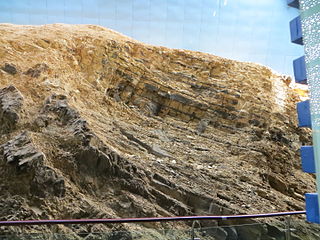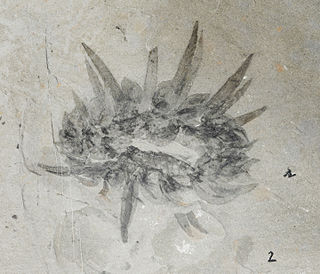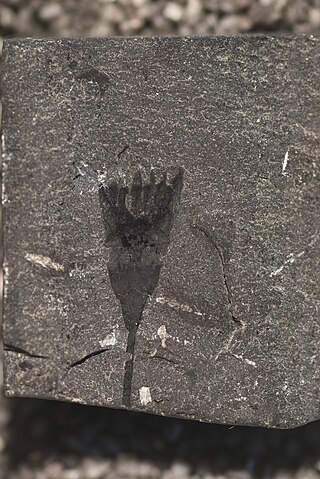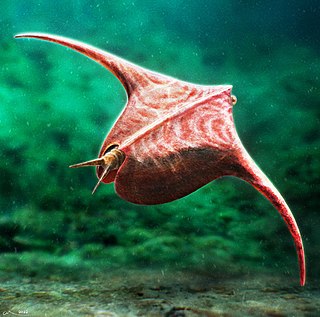
The Maotianshan Shales (帽天山页岩) are a series of Early Cambrian sedimentary deposits in the Chiungchussu Formation, famous for their Konservat Lagerstätten, deposits known for the exceptional preservation of fossilized organisms or traces. The Maotianshan Shales form one of some forty Cambrian fossil locations worldwide exhibiting exquisite preservation of rarely preserved, non-mineralized soft tissue, comparable to the fossils of the Burgess Shale of British Columbia, Canada. They take their name from Maotianshan Hill in Chengjiang County, Yunnan Province, China.

Wiwaxia is a genus of soft-bodied animals that were covered in carbonaceous scales and spines that protected it from predators. Wiwaxia fossils—mainly isolated scales, but sometimes complete, articulated fossils—are known from early Cambrian and middle Cambrian fossil deposits across the globe. The living animal would have measured up to 5 centimetres (2 in) when fully grown, although a range of juvenile specimens are known, the smallest being 2 millimetres (0.08 in) long.
The Kaili Formation(凯里組) is a stratigraphic formation which was deposited during the Lower and Middle Cambrian. The formation is approximately 200 metres (660 ft) thick and was named after the city Kaili in the Guizhou province of southwest China.

Dinomischusis an extinct genus of stalked filter-feeding animals within the Cambrian period, with specimens known from the Burgess Shale and the Maotianshan Shales. While long of uncertain affinities, recent studies have suggested it to be a stem-group ctenophore.

Leanchoilia is a megacheiran arthropod known from Cambrian deposits of the Burgess Shale in Canada and the Chengjiang biota of China.

Urokodia aequalis is an extinct genus of arthropod from the early Cambrian. The taxon is only known from the Maotianshan Shales of China based on some 15 specimens. Its segmentation resembles that of a millipede and it possessed head and tail shields with thorny spikes. It has some similarities to the arthropod Mollisonia that is known from both the Burgess Shale of Canada and the Kaili biota of China. Recently, the taxon has been considered a member of the order Mollisoniida, alongside Mollisonia, Thelxiope, and Corcorania, the group are suggested to be stem-chelicerates.
Gordia is an ichnofossil known from Precambrian to modern sediments and is the most common trace fossil in the Kaili biota displaying "smooth, cylindrical or subcylindrical, non-branching, winding and irregularly curving burrows, commonly self-overcrossing". Probably made by a worm-like creature displaying fodinichnial behaviour. It takes the form of unlined, curving parallel-walled burrows that often end with a nub, probably created as the creature probed the over- or under-lying sediment. It resembles Helminthopsis and Haplotichnus.
Bosworthia is a genus of branching photosynthetic alga known from the Middle Cambrian Burgess Shale. 20 specimens of Bosworthia are known from the Greater Phyllopod bed, where they comprise 0.04% of the community. One of its two original species has since been reassigned to Walcottophycus.

Mollisonia is an extinct genus of Cambrian arthropod. Species are known from the Burgess Shale, Langston Formation, and Wheeler Shale of North America, as well as the Chengjiang Biota of China. Twenty-one specimens of Mollisonia are known from the Greater Phyllopod bed, where they comprise less than 0.1% of the community. Remains possibly attributable to the genus are also known from the Ordovician Fezouata Formation of Morocco and Bøggild Fjord Formation in Greenland. An observation published in 2019 suggests this genus is a basal chelicerate, closer to crown group Chelicerata than members of Habeliida. It is suggested to be closely related to Corcorania, Urokodia, and Thelxiope, which together form the clade Mollisoniida, which are thought to be closely related to Chelicerata.

Eldoniids or eldonioids are an extinct clade of enigmatic disc-shaped animals which lived in the early to middle Paleozoic. They are characterized by their "medusoid" (jellyfish-shaped) bodies, with the form of a shallow dome opening below to an offset mouth supplemented by filamentous tentacles. Internally, they have a distinctive C-shaped cavity encompassing the gut, as well as hollow radial (radiating) structures arranged around a central ring canal. Most eldoniids are soft-bodied and can only be preserved in lagerstätten, but a few species may have hosted mineralized deposits. Historically, the affinities of eldoniids was enigmatic; recently, they been assessed as cambroernid deuterostomes. Their lifestyle is still an unresolved question; some authors reconstruct eldoniids as free-floating planktonic predators similar to jellyfish, while others argue that they were passive detritivores, embedded within the seabed for much of their life.
Stellostomites is a discoidal animal known from the Cambrian Chengjiang biota and classified with the eldoniids.
Paropsonema is a discoidal animal known from the Cambrian Chengjiang biota and possibly from Devonian formations in upstate New York. It is classified with the eldoniids.

Rotadiscus is a genus of discoidal animal known from the Cambrian Chengjiang biota and classified with the eldoniids.
Velumbrella is a medusoid organism with tentacles known from the Middle Cambrian of Poland, and perhaps related to Rotadiscus; the fossils depict a scleritosed disk with a U-shaped gut. It was originally related to members of the Ediacara biota but is now thought to be related to the paropsonemids.
Kailidiscus is an extinct genus of echinoderms which existed in what is now China during the Middle Cambrian period. It was named by Yuanlong Zhao, Colin D. Sumrall, Ronald L. Parsley and Jin Peng in 2010, and the type and only species is Kailidiscus chinensis. It bears close resemblance to the Burgess Shale fossil Walcottidiscus.

Helminthopsis is the ichnogenus of a type of trace fossil that is found preserved on the bedding planes of fine-grained sedimentary rocks. It is characterized by short, curvilinear, non-branching, parallel-sided, unlined traces on bedding surfaces. It is thought to represent the submarine feeding trails of an invertebrate organism that worked the surface of muddy substrates in search of food. Because Helminthopsis traces never cross over themselves, the ichnogenus is distinguished from similar traces assigned to the Gordia ichnogenus. The similar sounding, but now obsolete, ichnogenus Helminthoida refers to a somewhat similar trace characterized by regular, back-and-forth meanders, whereas Helminthopsis traces are irregular.

The cambroernids are a clade of unusual Paleozoic animals with coiled bodies and filamentous tentacles. They include a number of early to middle Paleozoic genera noted as "bizarre" or "orphan" taxa, meaning that their affinities with other animals, living or extinct, have long been uncertain. While initially defined as an "informal stem group," later work with better-preserved fossils has strengthened the argument for Cambroernida as a monophyletic clade.
The Miaolingian is the third Series of the Cambrian Period, and was formally named in 2018. It lasted from about 509 to 497 million years ago and is divided in ascending order into 3 stages: the Wuliuan, Drumian, and Guzhangian. The Miaolingian is preceded by the unnamed Cambrian Series 2 and succeeded by the Furongian series.

This is a list of the biota of the Burgess Shale, a Cambrian lagerstätte located in Yoho National Park in Canada.

Pseudoarctolepis is an extinct genus of bivalved arthropod known from the Cambrian period. The type species, P. sharpi was described by Brooks & Caster in 1956 from specimens found in the Wheeler Shale of Utah. It is unusual among Cambrian arthropods for having a pair of wing-like structures projecting outwards from the carapace. A second species, P. semicircularis has been described from the Kaili Biota in South China, which differs from the type species in the fact that the wings are semicircular rather than blade-like. A possible related form has been reported from the Ordovician of Portugal. They were relatively large, with some carapaces of P. sharpi reaching 11 centimetres (4.3 in) in length. The soft-bodied anatomy is poorly known, though the poorly preserved posterior anatomy of a specimen of P. sharpi is known, which consists of a narrow segmented abdomen, which ends with a pair of caudal rami. They are thought to have been actively swimming nektonic organisms. Affinities to the bivalved arthropod group Hymenocarina have been proposed, but the limited knowledge of the anatomy makes the referral tentative.











